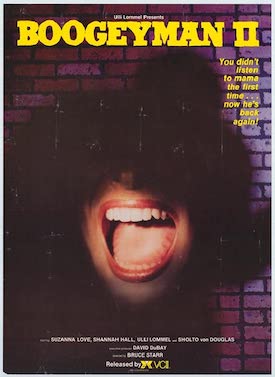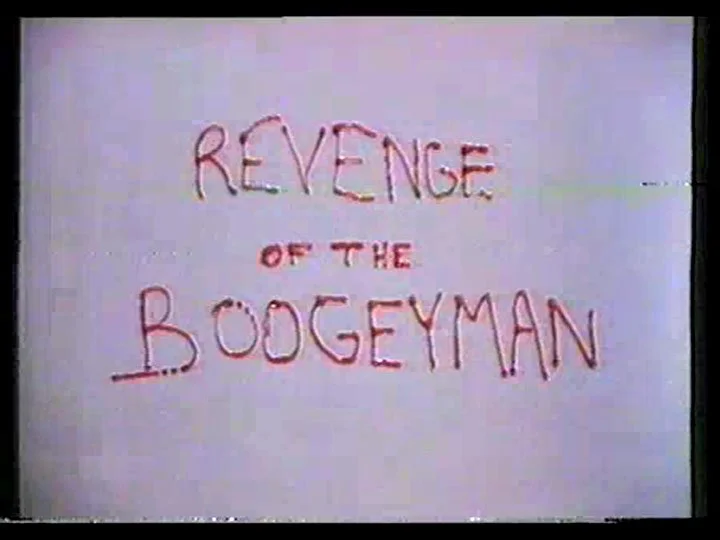The Boogeyman II (reviewed by Lisa Marie Bowman)
Filmed in 1982 but not released until 1984, Boogeyman II is — as the name implies — the sequel to 1980’s The Boogeyman.
What’s that, you say? You don’t remember anything about The Boogeyman and you don’t want to take the time to read my review of it? Well, don’t worry. It’s not necessary to have seen the original Boogeyman to follow the sequel, largely because the sequel is full of flashbacks to the first film. Boogeyman II is only 79 minutes long and 30 minutes of that running time is taken up with footage from the first Boogeyman. Indeed, if you want to see the good parts of Boogeyman without having to deal with any of the filler, I would recommend just watching the first 30 minutes of Boogeyman II.
There is a plot to Boogeyman II, kind of. Having survived the massacre of her family at the farm, the now-divorced Lacey (played by Suzanna Love, the then-wife of director Ulli Lommel) goes out to California to visit her friends, actress Bonnie (Shannah Hall) and her husband, director Mickey (Lommel). How is it that Lacey, who was portrayed as being a simple and not particularly worldly farm wife in the first film, happens to be friends with a wealthy actress and director? It’s never really explained.
Bonnie and Mickey ask Lacey whether or not the people who killed her family were ever caught. Lacey replies that they can’t be caught because they’re spirits. Over dinner, Lacey tells Bonnie and Mickey the story of the shattered mirror and the killer whose spirit was trapped in the broken glass. Bonnie and Mickey listen sympathetically, though they both think that Lacey’s crazy. (Perhaps they noticed that Lacey’s flashbacks include scenes in which she wasn’t even present. Or maybe they’re wondering why Lacey would take the time to apparently describe a lengthy, bondage-themed nightmare that she had during the first film. Or maybe they’re just amazed by the presence of John Carradine in the flashbacks.) Bonnie and Mickey also think that Lacey’s story would make a great movie!
For some reason, Lacey is still carrying around a piece of the haunted mirror. This is the mirror that contains the spirit that possessed her during the first film and which killed the majority of her family. I would throw that piece of the mirror away but I guess Lacey’s more sentimental than I am. A creepy butler named Joseph (Sholto von Douglas, a rather stiff actor who still had a fascinatingly menacing screen presence) steals the piece of the mirror and soon, Hollywood phonies are dying.
Boogeyman II was directed by the late Ulli Lommel, a German director who got his start as an associate of Rainer Werner Fassbinder’s and who eventually came to America, where he hung out with Andy Warhol, directed some documentaries about the American punk scene, and married heiress Suzanna Love. Love bankrolled Lommel’s early films, including The Boogeyman. With Lommel, it was always a challenge to figure out how seriously he took any of his films. In interviews, he would joke about being an exploitation filmmaker while, at the same time, claiming that his films were designed to expose the hypocrisy of American society. Boogeyman II is full of phony Hollywood types and there’s a scene where Mickey comments that, in America, “exploitation is a genre.” It’s probably not a coincidence that it’s the servant, Joseph, who uses the mirror to take out the film’s wealthy victims. The opening credits of Boogeyman II appear to literally be written in magic marker. Is Lommel mocking expensive Hollywood productions or could Lommel only afford a box of magic markers? I suppose both could be true.
The best parts of Boogeyman II are the flashback to the first film, which was a genuinely atmospheric horror film with some serious pacing issues. The rest of Boogeyman II is dull, though you do have to appreciate the sense of ennui that Lommel brings to the proceedings. Was the ennui intentional? That’s the mystery of Ulli Lommel.
As for Lommel, he and Love eventually divorced and Lommel ended his career making trashy true crime films that went direct-to-video. As usual, Lommel claimed that his crime films were meant to be a serious critique of everything that was wrong with America. Lommel’s true crime films have none of the atmosphere or occasional flashes of wit that distinguished Lommel’s earlier films. Was Lommel an incompetent director or was he a subversive artist? Again, both could be true. Lommel died in 2017, bringing to close an enigmatic career.


